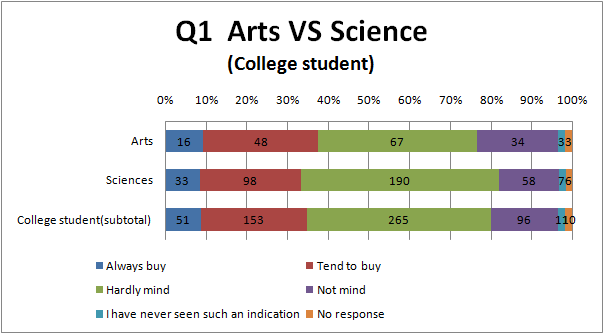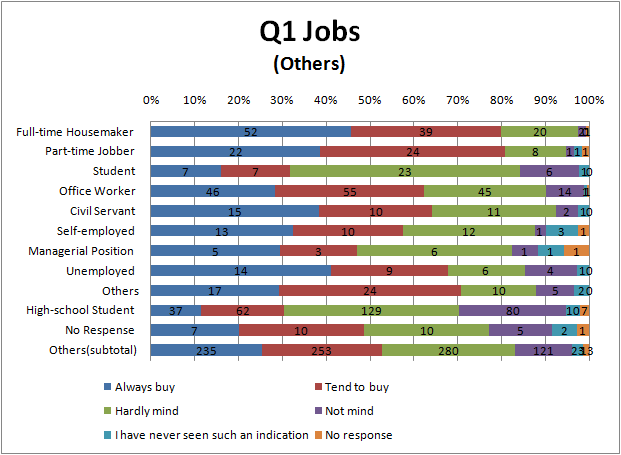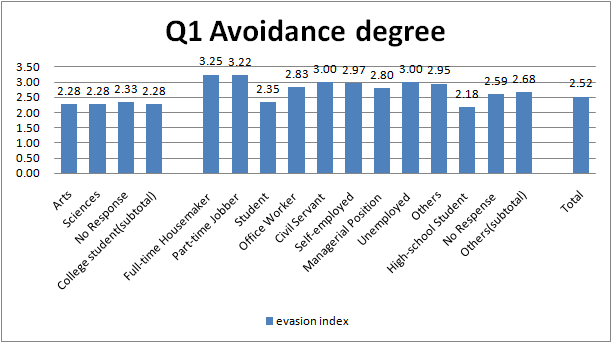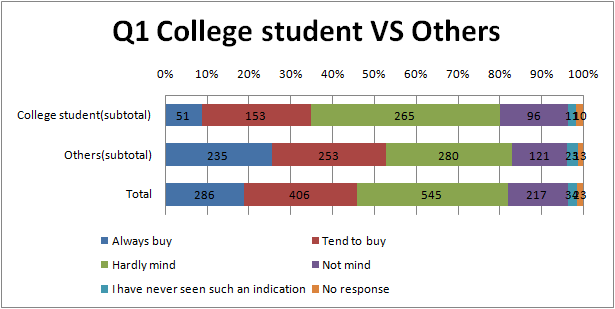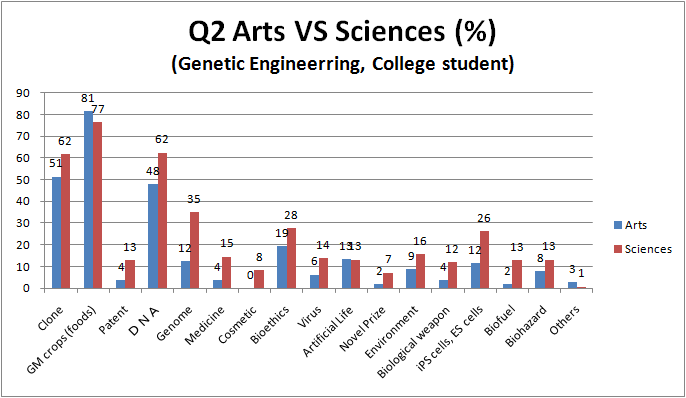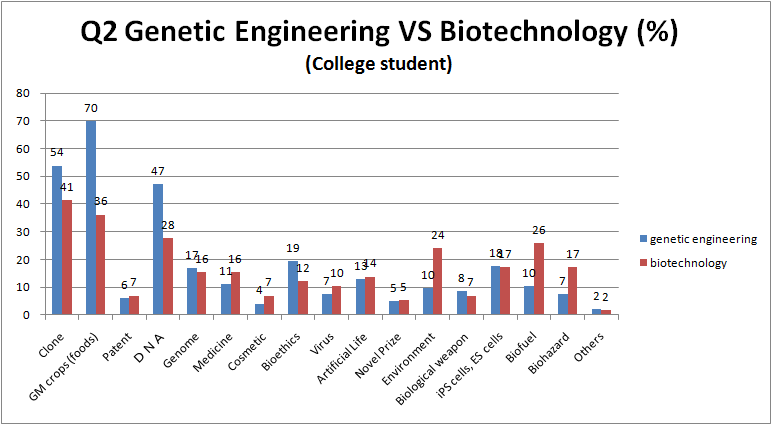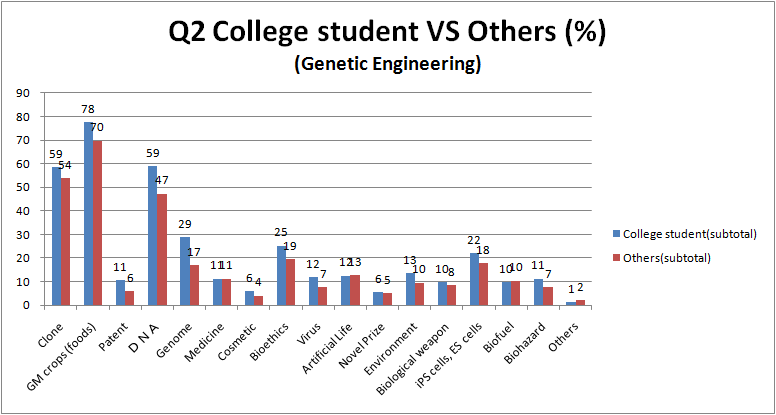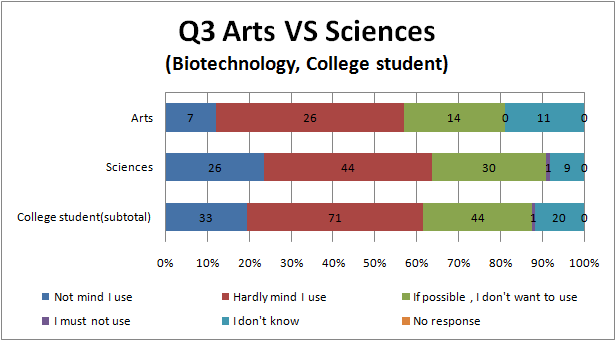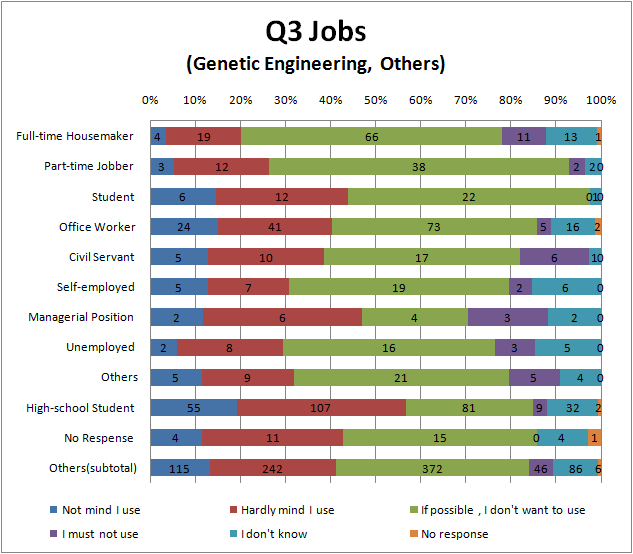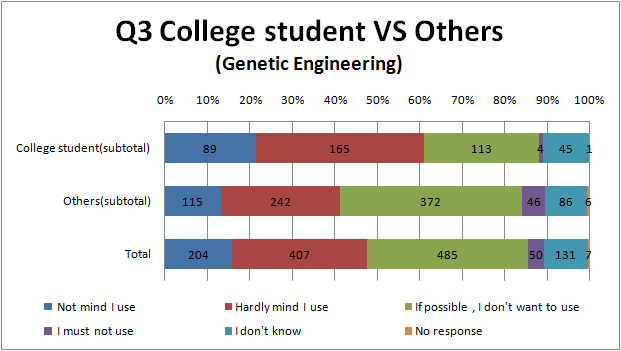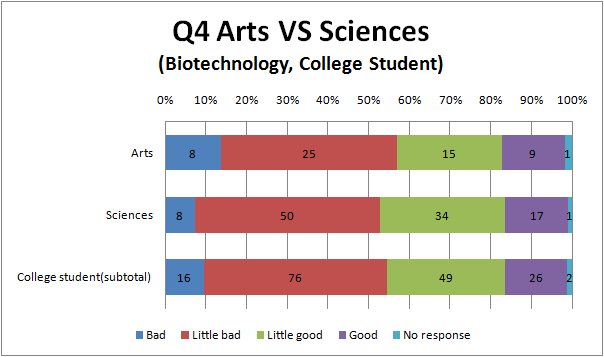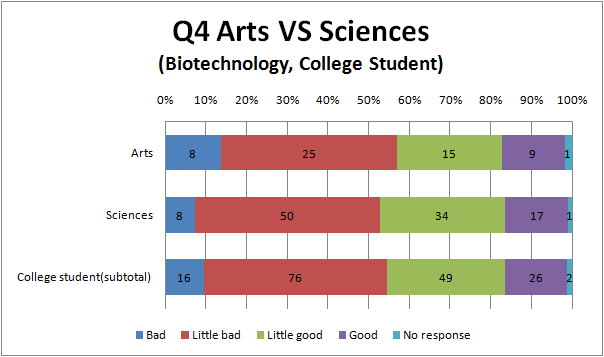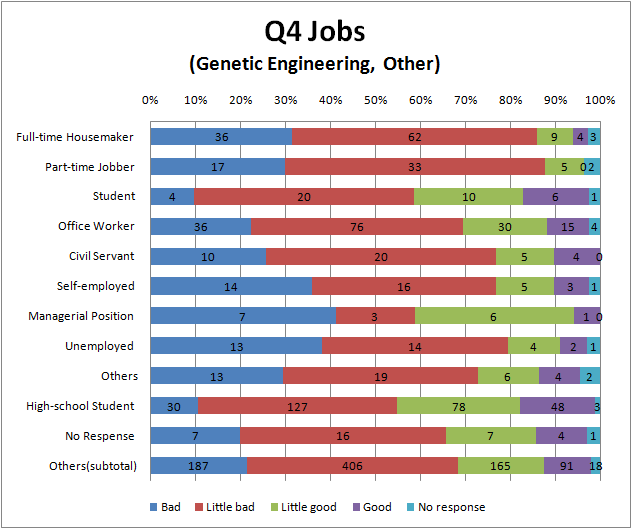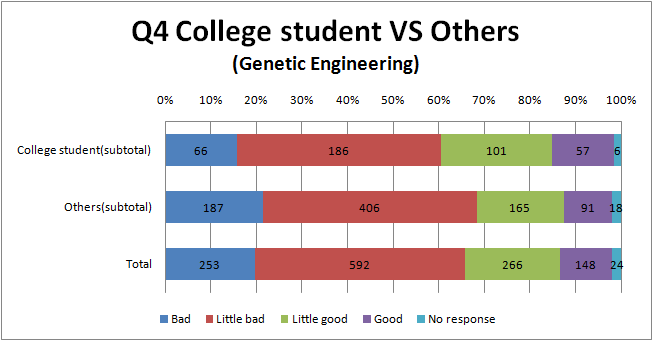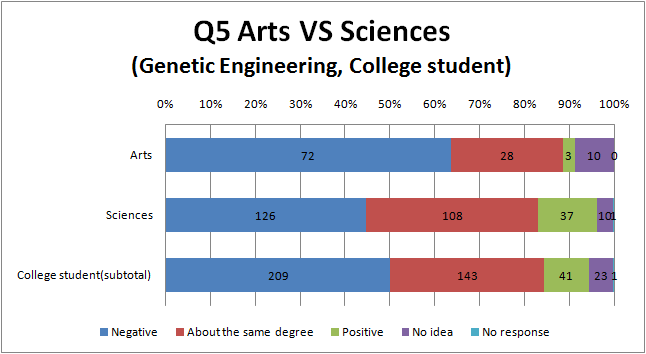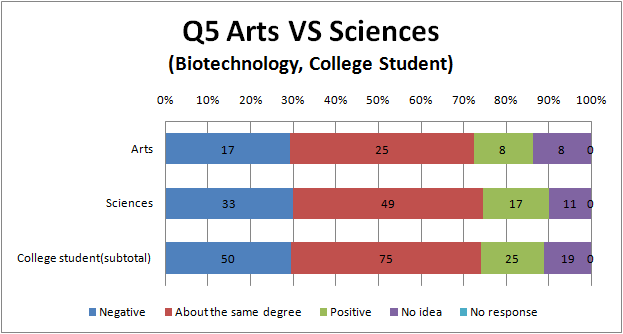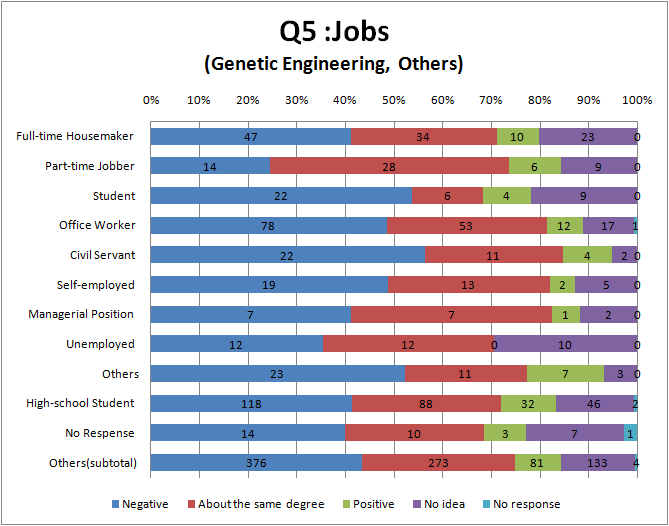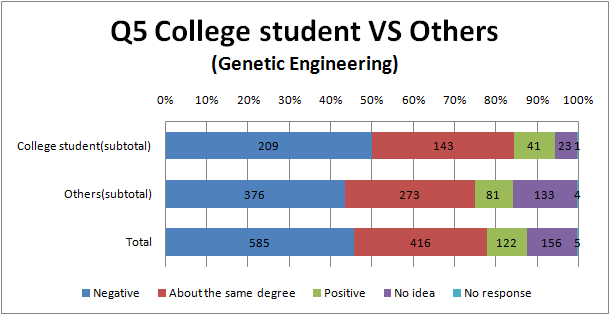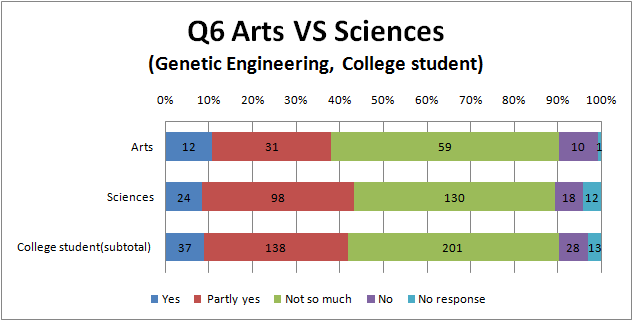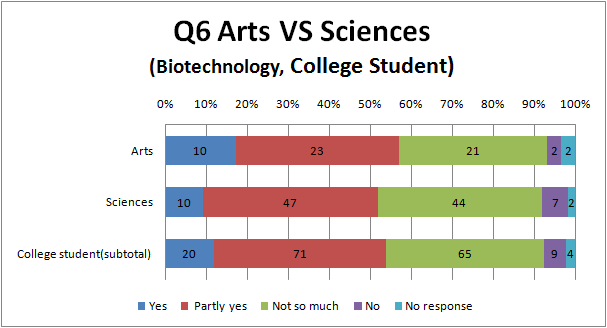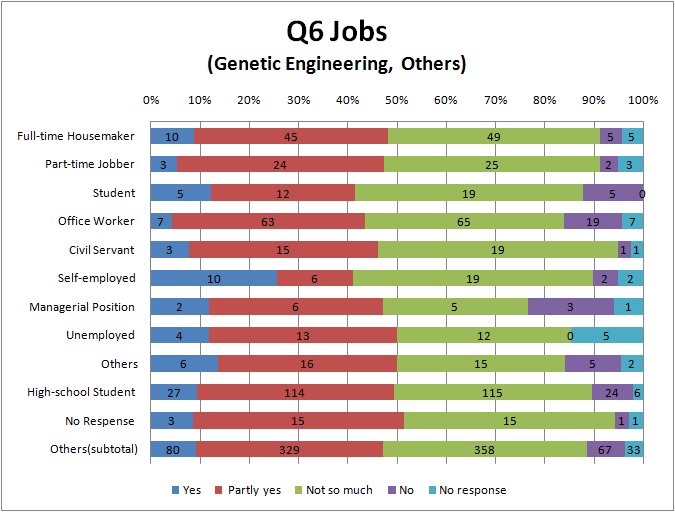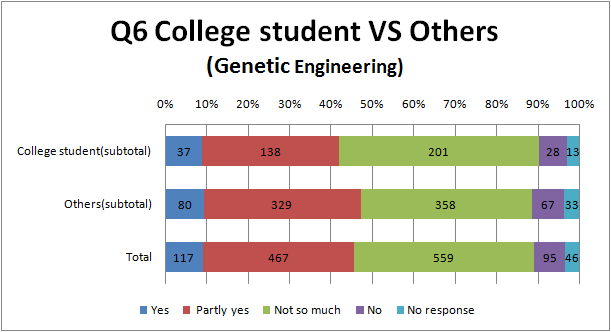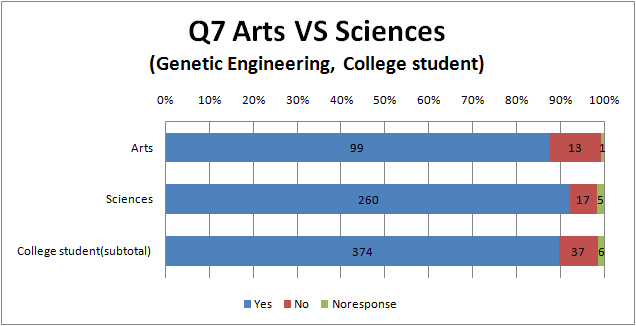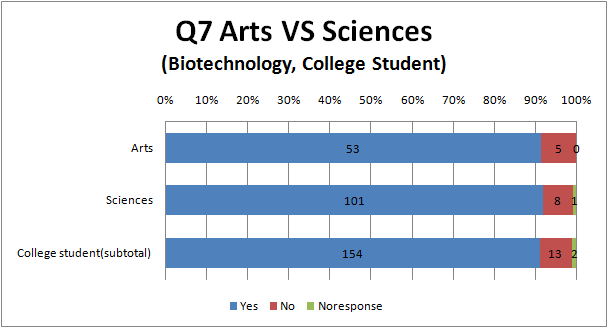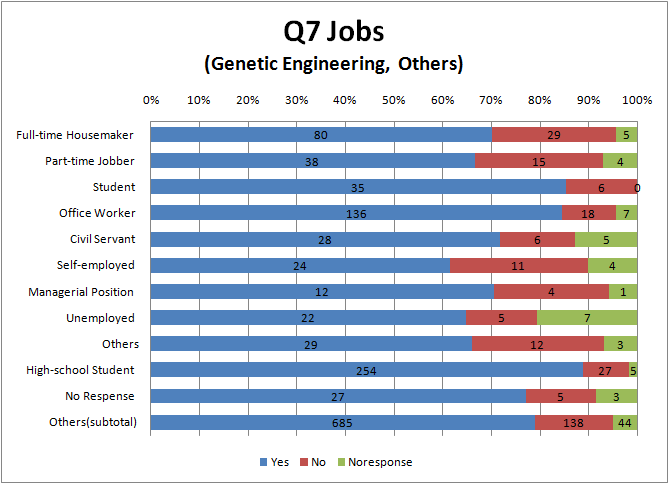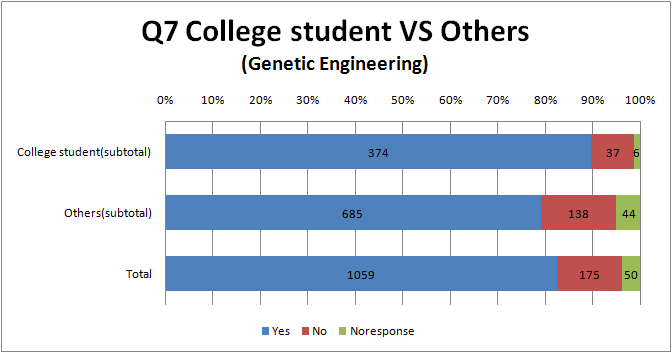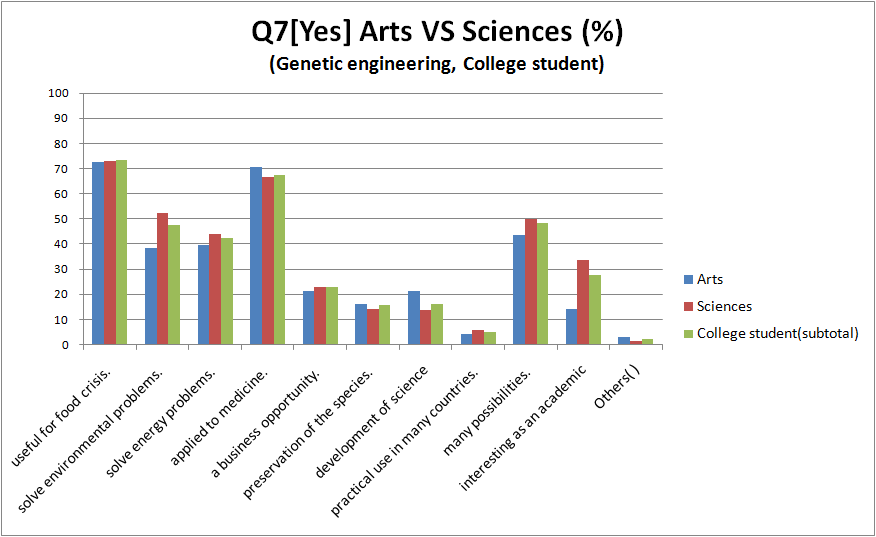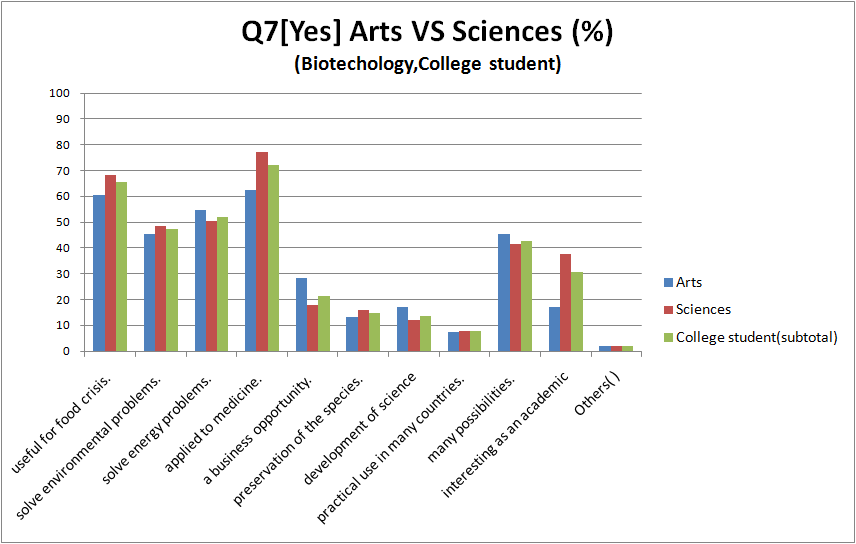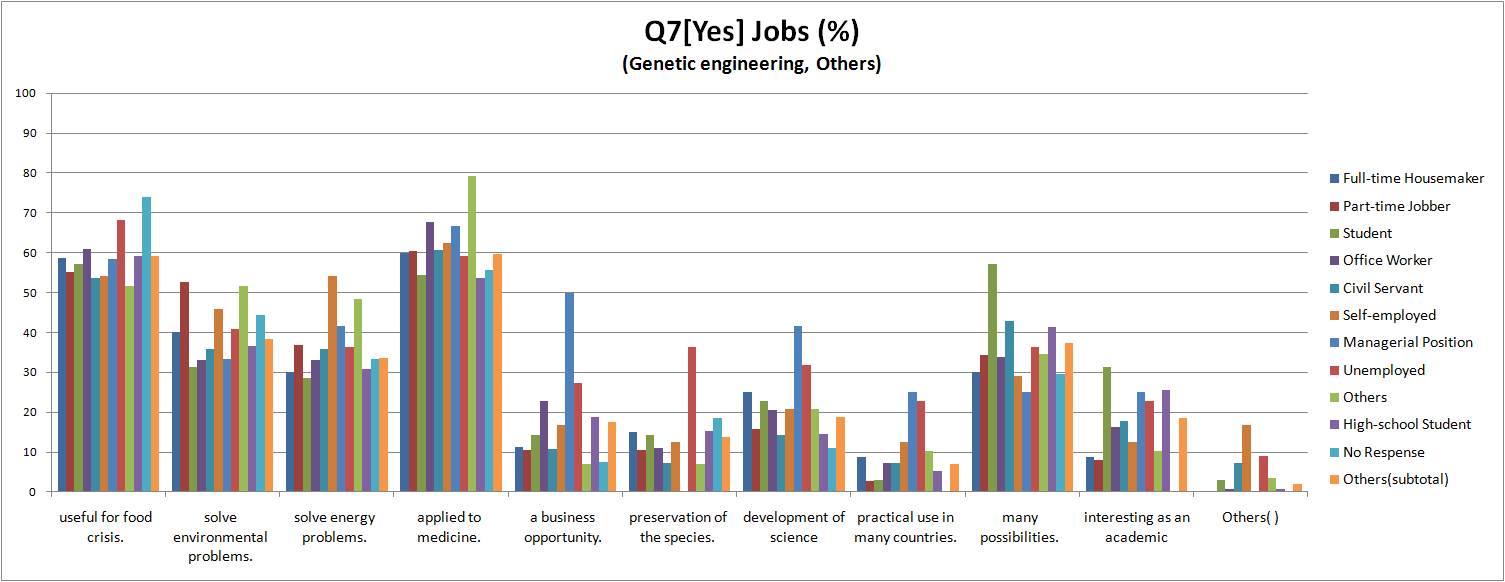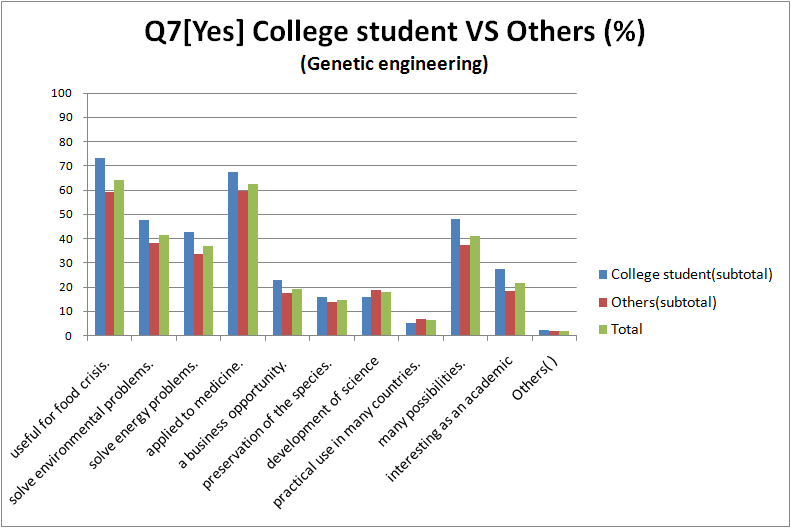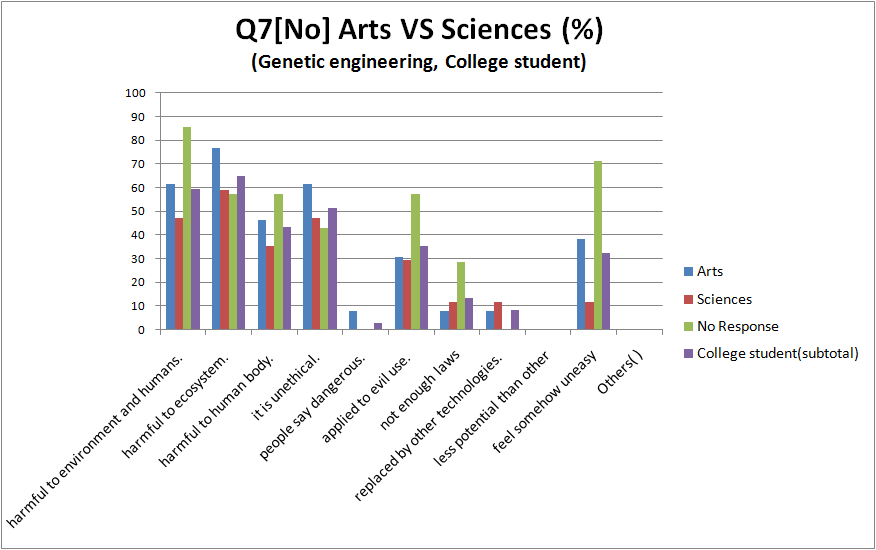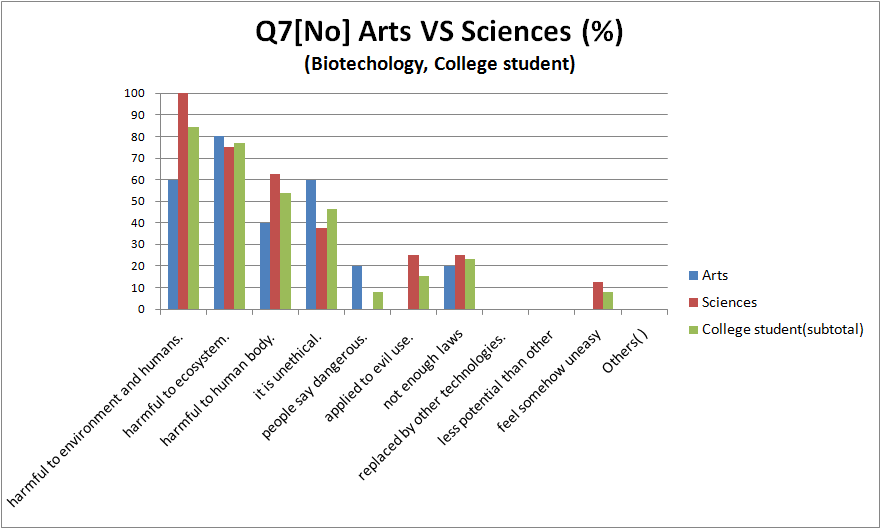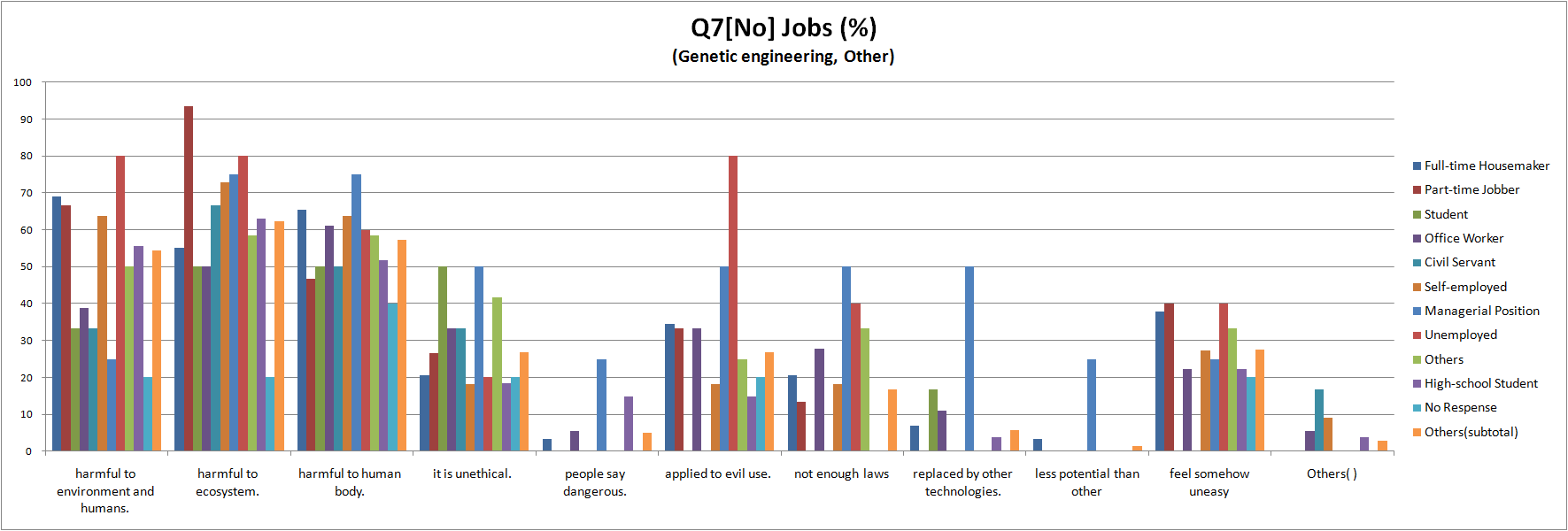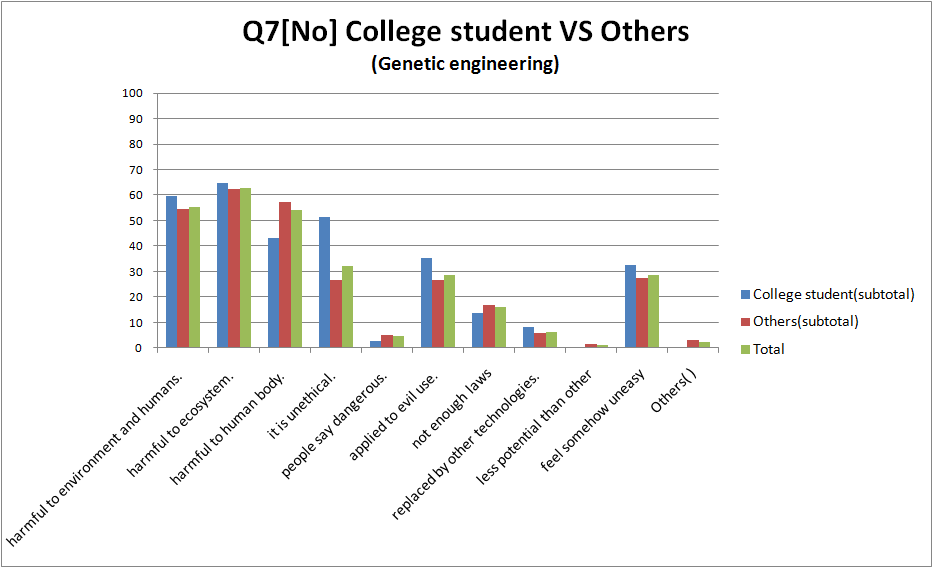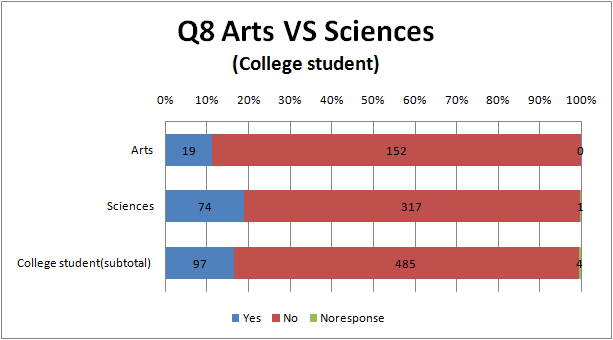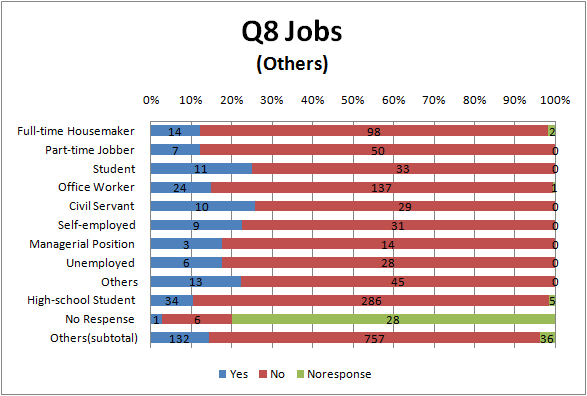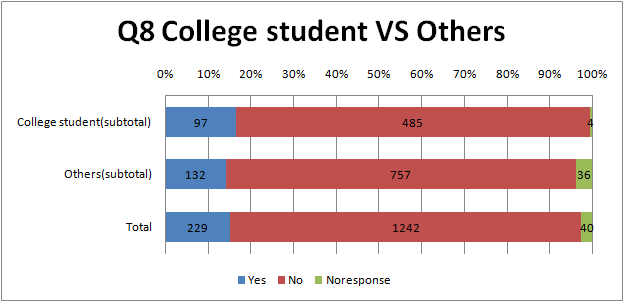Team:Osaka/HumanPractice
From 2010.igem.org
(New page: {{Osaka}} ==HumanPractices== ===Abstract=== iGEM Kyoto suggested '''a nationwide survey''' to all the iGEM teams in Japan this year. Five Universities (including Kyoto) participated in th...) |
|||
| (2 intermediate revisions not shown) | |||
| Line 1: | Line 1: | ||
{{Osaka}} | {{Osaka}} | ||
| + | <html> | ||
| + | <div class="contents2"> | ||
| + | </html> | ||
==HumanPractices== | ==HumanPractices== | ||
===Abstract=== | ===Abstract=== | ||
| Line 344: | Line 347: | ||
=====Future work ===== | =====Future work ===== | ||
| - | We investigated the tendency of impressions on genetic engineering through comparison between Japanese (different ages, majors, job, and regions). We | + | We investigated the tendency of impressions on genetic engineering through comparison between Japanese (different ages, majors, job, and regions).We hoped that people became more familier |
| - | + | with synthetic biology. | |
[[#top-section|^Top]] | [[#top-section|^Top]] | ||
| Line 354: | Line 357: | ||
[[#top-section|^Top]] | [[#top-section|^Top]] | ||
| - | + | <html> | |
| - | + | </div> | |
| + | <div class="clear"><hr></div> | ||
| + | </html> | ||
| + | {{Osaka_foot}} | ||
| + | <html> | ||
| + | </html> | ||
Latest revision as of 03:29, 28 October 2010
HumanPractices
Abstract
iGEM Kyoto suggested a nationwide survey to all the iGEM teams in Japan this year. Five Universities (including Kyoto) participated in this project. We Kyoto team led other teams in the project, and successfully got over 1,500 answers in total! From the survey, we found that opinions differ between students and non-students. To our little surprise, the survey also showed that the majority of Japanese regard biotechnology favorably, while at the same time they worry very much about the safety.
Introduction
This year, we iGEM Japan carried out ”iGEM Japan Human Practices” suggested by iGEM Kyoto. In this project, we drove an attitude survey on genetic engineering and biotechnology cooperating with one another. We attempted to recognize the current situation of Japanese public view, and we will take advantage of this result for future human practice activities.
Motivation
According to the previous result of human practice activity, which was a survey with questions about genetic engineering, more Japanese people chose "negative" or "neutral" than the other nationalities [1]. In addition, it is often said that many Japanese people hate or avoid genetically modified food [2]. We are interested in this tendency. Thus, we attempted to investigate the reason why many Japanese people have a negative impression on genetic engineering. We made a questionnaire below, asking about the impressions on genetic engineering and words related to iGEM, or Synthetic biology.
Advantages
- By combining the results from different teams located in the different regions to share some steps of human practice activities, we can avoid labor-intensive but also improve the quality of the survey result with rich amount of samples.
- We can attract public attention such as Mass-media by driving this activity as iGEM Japan, than as one university team. This will be a great help for many purposes, such as announcing the activities of iGEM, inviting sponsors, or further human practices activities.
- This project will be a good opportunity to deepen the relationships between each Japanese iGEMers. Actually, we are planning iGEM JAPAN project, which includes not only human practice activities but also construction of iGEM JAPAN Website, PR by magazines and participation in symposiums for example.
[ This is the common Introduction article of participating universities of “iGEM Japan Human Practices”(KIT-Kyoto, Kyoto, Osaka, Tokyo_Metropolitan, and UT-Tokyo). iGEM Kyoto has the responsibility for the wording. ]
Methods
Five out of the nine Japanese teams, KIT-Kyoto, Kyoto, Osaka, Tokyo_Metropolitan, and UT-Tokyo took part in this project. We all used paper-based questionnaires, but the sites for the survey and the terms used in the questions varied depending on the team.
The survey was conducted from June 30 to September 26 in places near our universities.
Targets, Terms, and Places
KIT-Kyoto
- Students
- July 12 - September 26 at Kyoto Institute of Technology University
- Others
- August 10 at Open Campus in Kyoto Institute of Technology University
Kyoto
- Students
- July 12 - September 26 at Kyoto University
- Others
- August 28, 29 at Masukata Shopping Street, Kyoto
- September 4 at Grace Tanaka, a supermarket, Kyoto
- September 11, 12 at Coop Shimogamo, Kyoto
Osaka
- Others
- August 10 at Osaka University from high school student or their parents
Tokyo_Metropolitan
- Students
- July 1 - September 26 at Tokyo Metropolitan University
- July 30 - September 26 (Tokyo_Metropolitan team member’s friends)
- Others
- June 30 - July 2 in BIO EXPO JAPAN (http://www.bio-expo.jp/en/Home/) at Tokyo.
- July 16 in Public Forum on Education Development Project at Tokyo Metropolitan University
- July 18, August 20 in Open Lab at Tokyo Metropolitan University
- September 18, 19 in Mitaka Science and Technology Fair at Tokyo
- August 7 - September 26 (Tokyo_Metropolitan team member's family and acquaintances)
UT-Tokyo
- Others (High School Students)
- July 31 at SEG, a cram school, Tokyo
Questionnaire
We prepared two (very similar) questionnaires: "Attitude survey of genetic engineering" and "Attitude survey of biotechnology." They are almost the same, but "Attitude survey of biotechnology" contains a little different question from "Attitude survey of genetic engineering". We only changed the word "genetic engineering" of the survey for "biotechnology" in order to make "Attitude survey of biotechnology."
And we attempted to indicate difference of image between "genetic engineering" and "biotechnology".
Attitudes survey of ( genetic engineering or biotechnology )
- When shopping, do you buy "non-genetically modified food”?
- [ Always buy / Tend to buy / Hardly mind / Not mind / I have never seen such an indication ]
- What do you associate with ( genetic engineering or biotechnology )? (※Please encircle all that apply)
- [ Clone / GM crops (foods) / Patent / DNA / Genome / Medicine / Cosmetic / Bioethics / Virus / Artificial Life / Novel Prize / Environment / Biological weapon / iPS cells, ES cells / Biofuel / Biohazard / Others( ) ]
- If there is no difference in effectiveness, what do you think about using the drugs manufactured by ( genetic engineering or biotechnology )?
- [ Not mind I use / Hardly mind I use / If possible, I don't want to use / I must not use / I don't know ]
- What do you think of the artificial genetic mutation by ( genetic engineering or biotechnology )?
- [ Bad / Little bad / Little good / Good ]
- Which trend of information about ( genetic engineering or biotechnology ) is major, negative or positive?
- [ Negative / About the same degree / Positive / No idea ]
- Do you think Japan actively tackles on ( genetic engineering or biotechnology )?
- [ Yes / Partly yes / Not so much / No ]
- Do you think the research on ( genetic engineering or biotechnology ) should continue?
- [ Yes / No ]
- If you answered [Yes], please encircle every fit reason from below.
- Because it may be useful for food crisis.
- Because it may solve environmental problems.
- Because it may solve energy problems.
- Because it may be applied to medicine.
- Because it may create a business opportunity.
- Because it can be used in the preservation of the species.
- Because it symbolizes the development of science and technology.
- Because it has already been put to practical use in many countries.
- Because it has many possibilities.
- Because it is interesting as an academic subject or a research topic.
- Others( )
- If you answered [No], please encircle every reason from below.
- Because it can create evil things harmful to environment and humans.
- Because products of it can be harmful to ecosystem.
- Because products of it can be harmful to human body.
- Because it is unethical.
- Because people say it is dangerous.
- Because it can be applied to evil use.
- Because there are not enough laws governing it.
- Because it can be replaced by other technologies.
- Because it seems to have less potential than other technologies.
- Because I feel somehow uneasy in using it.
- Others( )
- Have you ever heard the word, "Synthetic biology"?
- [ Yes / No ]
[ This is the common Method article of participating universities of “iGEM Japan Human Practice”(KIT-Kyoto, Kyoto, Osaka, Tokyo_Metropolitan, and UT-Tokyo).iGEM Kyoto has the responsibility for the wording. ]
Results
We drove this survey from July to September 26th.
All data: HumanPractice.xls
Our result is too much to write all on this page. So we write only graphs on this page and upload all result data. We analyzed mainly following points.
- compare between arts and science(*) in college student
- compare between "genetic engineering" and "biotechnology"
- compare between people with different jobs
- compare between college student and the others
(*)In Japan, classification of arts and science is important. Most Japanese students study different subjects since high school due to the classification, because it is a big factor to decide the subjects required in the entrance examination for universities or colleges. This is the reason we predicted that there might be some differences between arts and science.
Scale
Following is the scale of our survey(whole iGEM Japan.)
| College Student | ||||
| No. | Arts or Science | Genetic Engineering | Biotechnology | Subtotal |
|---|---|---|---|---|
| 1 | Arts | 113 | 58 | 171 |
| 2 | Sciences | 282 | 110 | 392 |
| 0 | No response | 22 | 1 | 23 |
| - | Total | 417 | 169 | 586 |
| Others | ||||
| No. | Job | Genetic Engineering | Biotechnology | Subtotal |
| 1 | Full-time House maker | 114 | 0 | 114 |
| 2 | Part-time Jobber | 57 | 0 | 57 |
| 3 | Student | 41 | 3 | 44 |
| 4 | Office Worker | 161 | 1 | 162 |
| 5 | Civil Servant | 39 | 0 | 39 |
| 6 | Self-employed | 39 | 1 | 40 |
| 7 | Managerial Position | 17 | 0 | 17 |
| 8 | Unemployed | 34 | 0 | 34 |
| 9 | Others | 44 | 14 | 58 |
| 10 | High-school Student | 286 | 39 | 325 |
| 0 | No Response | 35 | 0 | 35 |
| - | Subtotal | 867 | 58 | 925 |
| - | Total | 1284 | 227 | 1511 |
| Male | 771 |
| Female | 702 |
| No Response | 38 |
| Total | 1511 |
Graph
1. When shopping, do you buy "non-genetically modified food”?
- [ Always buy / Tend to buy / Hardly mind / Not mind / I have never seen such an indication ]
2. What do you associate with ( genetic engineering or biotechnology )? (※Please encircle all that apply)
- [ Clone / GM crops (foods) / Patent / DNA / Genome / Medicine / Cosmetic / Bioethics / Virus / Artificial Life / Novel Prize / Environment / Biological weapon / iPS cells, ES cells / Biofuel / Biohazard / Others( ) ]
3. If there is no difference in effectiveness, what do you think about using the drugs manufactured by ( genetic engineering or biotechnology )?
- [ Not mind I use / Hardly mind I use / If possible, I don't want to use / I must not use / I don't know ]
4. What do you think of the artificial genetic mutation by ( genetic engineering or biotechnology )?
- [ Bad / Little bad / Little good / Good ]
5. Which trend of information about ( genetic engineering or biotechnology ) is major, negative or positive?
- [ Negative / About the same degree / Positive / No idea ]
6. Do you think Japan actively tackles on ( genetic engineering or biotechnology )?
- [ Yes / Partly yes / Not so much / No ]
7 Do you think the research on ( genetic engineering or biotechnology ) should continue?
- [ Yes / No ]
- If you answered [Yes], please encircle every fit reason from below.
- Because it may be useful for food crisis.
- Because it may solve environmental problems.
- Because it may solve energy problems.
- Because it may be applied to medicine.
- Because it may create a business opportunity.
- Because it can be used in the preservation of the species.
- Because it symbolizes the development of science and technology.
- Because it has already been put to practical use in many countries.
- Because it has many possibilities.
- Because it is interesting as an academic subject or research topic.
- Others( )
- If you answered [No], please encircle every reason from below.
- Because it can create evil things harmful to environment and humans.
- Because products of it can be harmful to ecosystem.
- Because products of it can be harmful to human body.
- Because it is unethical.
- Because people say it is dangerous.
- Because it can be applied to evil use.
- Because there are not enough laws governing it.
- Because it can be replaced by other technologies.
- Because it seems to have less potential than other technologies.
- Because I feel somehow uneasy in using it.
8. Have you ever heard the word, "Synthetic biology"?
- [ Yes / No ]
[ This is the common Result article of participating universities of “iGEM Japan Human Practice”(KIT-Kyoto, Kyoto, Osaka, Tokyo_Metropolitan, and UT-Tokyo).iGEM Kyoto has the responsibility for the wording. ]
Future work
We investigated the tendency of impressions on genetic engineering through comparison between Japanese (different ages, majors, job, and regions).We hoped that people became more familier with synthetic biology.
 "
"

